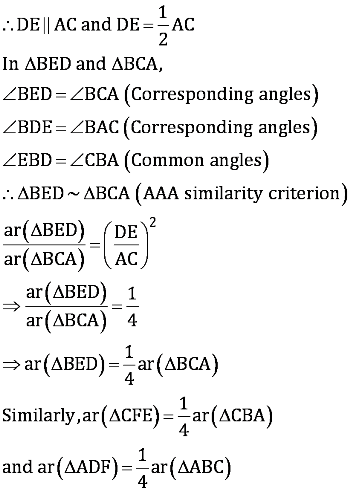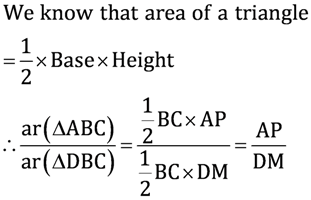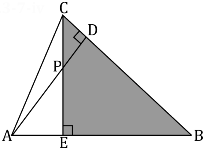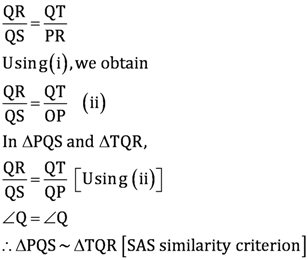Question 5:
D, E and F are respectively the mid-points of sides AB, BC and CA of ; ABC. Find the ratio of the area of ∆DEF and ∆ABC.
Answer:

D and E are the mid-points of ∆ABC.


Exams Question Papers General Knowledge Election Directory
Question 5:
D, E and F are respectively the mid-points of sides AB, BC and CA of ; ABC. Find the ratio of the area of ∆DEF and ∆ABC.
Answer:

D and E are the mid-points of ∆ABC.


Question 4:
If the areas of two similar triangles are equal, prove that they are congruent.
Answer:
Let us assume two similar triangles as ∆ABC ∼ ∆PQR.

Question 3:
In the following figure, ABC and DBC are two triangles on the same base BC. If AD intersects BC at O, show that 

Answer:
Let us draw two perpendiculars AP and DM on line BC.


In ∆APO and ∆DMO,
∠APO = ∠DMO (Each = 90°)
∠AOP = ∠DOM (Vertically opposite angles)
∴ ∆APO ∼ ∆DMO (By AA similarity criterion)

Question 2:
Diagonals of a trapezium ABCD with AB || DC intersect each other at the point O. If AB = 2CD, find the ratio of the areas of triangles AOB and COD.
Answer:

Since AB || CD,
∴ ∠OAB = ∠OCD and ∠OBA = ∠ODC (Alternate interior angles)
In ∆AOB and ∆COD,
∠AOB = ∠COD (Vertically opposite angles)
∠OAB = ∠OCD (Alternate interior angles)
∠OBA = ∠ODC (Alternate interior angles)
∴ ∆AOB ∼ ∆COD (By AAA similarity criterion)

Question 1:
Let ∆ABC ~ ∆DEF and their areas be, respectively, 64 cm2 and 121 cm2. If EF = 15.4 cm, find BC.
Answer:

Question 16:
If AD and PM are medians of triangles ABC and PQR, respectively where Δ ABC ~ Δ PQR, prove that AB/PQ = AD/PM.
Answer:

It is given that ΔABC ∼ ΔPQR
We know that the corresponding sides of similar triangles are in proportion.

Question 15:
A vertical pole of a length 6 m casts a shadow 4m long on the ground and at the same time a tower casts a shadow 28 m long. Find the height of the tower.
Answer:

Let AB and CD be a tower and a pole respectively.
Let the shadow of BE and DF be the shadow of AB and CD respectively.
At the same time, the light rays from the sun will fall on the tower and the pole at the same angle.
Therefore, ∠DCF = ∠BAE
And, ∠DFC = ∠BEA
∠CDF = ∠ABE (Tower and pole are vertical to the ground)
∴ ∆ABE ∼ ∆CDF (AAA similarity criterion)

Therefore, the height of the tower will be 42 metres.
Question 14:
Sides AB and AC and median AD of a triangle ABC are respectively proportional to sides PQ and PR and median PM of another triangle PQR. Show that ∆ABC ~ ∆PQR
Answer:

Given that,

Let us extend AD and PM up to point E and L respectively, such that AD = DE and PM = ML. Then, join B to E, C to E, Q to L, and R to L.

We know that medians divide opposite sides.
Therefore, BD = DC and QM = MR
Also, AD = DE (By construction)
And, PM = ML (By construction)
In quadrilateral ABEC, diagonals AE and BC bisect each other at point D.
Therefore, quadrilateral ABEC is a parallelogram.
∴ AC = BE and AB = EC (Opposite sides of a parallelogram are equal)
Similarly, we can prove that quadrilateral PQLR is a parallelogram and PR = QL, PQ = LR
It was given that

∴ ∆ABE ∼ ∆PQL (By SSS similarity criterion)
We know that corresponding angles of similar triangles are equal.
∴ ∠BAE = ∠QPL … (1)
Similarly, it can be proved that ∆AEC ∼ ∆PLR and ∠CAE = ∠RPL … (2)
Adding equation (1) and (2), we obtain
∠BAE + ∠CAE = ∠QPL + ∠RPL
⇒ ∠CAB = ∠RPQ … (3)
In ∆ABC and ∆PQR,
AB/PQ = AC/PR (Given)
∠CAB = ∠RPQ [Using equation (3)]
∴ ∆ABC ∼ ∆PQR (By SAS similarity criterion)
Question 13:
D is a point on the side BC of a triangle ABC such that ∠ADC = ∠BAC. Show that CA2 = CB.CD.
Answer:

In ∆ADC and ∆BAC,
∠ADC = ∠BAC (Given)
∠ACD = ∠BCA (Common angle)
∴ ∆ADC ∼ ∆BAC (By AA similarity criterion)
We know that corresponding sides of similar triangles are in proportion.

Question 12:
Sides AB and BC and median AD of a triangle ABC are respectively proportional to sides PQ and QR and median PM of ∆PQR (see the given figure). Show that ∆ABC ∼ ∆PQR.
Answer:

Median divides the opposite side.


⇒ ∠ABD = ∠PQM (Corresponding angles of similar triangles)
In ∆ABC and ∆PQR,
∠ABD = ∠PQM (Proved above)
AB/PQ = BC/QR
∴ ∆ABC ∼ ∆PQR (By SAS similarity criterion)
Question 11:
In the following figure, E is a point on side CB produced of an isosceles triangle ABC with AB = AC. If AD ⊥ BC and EF ⊥ AC, prove that ∆ABD ∼ ∆ECF

Answer:
It is given that ABC is an isosceles triangle.
∴ AB = AC
⇒ ∠ABD = ∠ECF
In ∆ABD and ∆ECF,
∠ADB = ∠EFC (Each 90°)
∠BAD = ∠CEF (Proved above)
∴ ∆ABD ∼ ∆ECF (By using AA similarity criterion)
Question 10:
CD and GH are respectively the bisectors of ∠ACB and ∠EGF such that D and H lie on sides AB and FE of ∆ABC and ∆EFG respectively. If ∆ABC ∼ ∆FEG, Show that:
(i) CD/GH = AC/FG
(ii) ∆DCB ∼ ∆HGE
(iii) ∆DCA ∼ ∆HGF
Answer:

It is given that ∆ABC ∼ ∆FEG.
∴ ∠A = ∠F, ∠B = ∠E, and ∠ACB = ∠FGE
∠ACB = ∠FGE
∴ ∠ACD = ∠FGH (Angle bisector)
And, ∠DCB = ∠HGE (Angle bisector)
In ∆ACD and ∆FGH,
∠A = ∠F (Proved above)
∠ACD = ∠FGH (Proved above)
∴∆ACD ∼ ∆FGH (By AA similarity criterion)
⇒ CD/GH = AC/FG
In ∆DCB and ∆HGE,
∠DCB = ∠HGE (Proved above)
∠B = ∠E (Proved above)
∴ ∆DCB ∼ ∆HGE (By AA similarity criterion)
In ∆DCA and ∆HGF,
∠ACD = ∠FGH (Proved above)
∠A = ∠F (Proved above)
∴ ∆DCA ∼ ∆HGF (By AA similarity criterion)
Question 9:
In the following figure, ABC and AMP are two right triangles, right angled at B and M respectively, prove that:

(i) ∆ABC ∼ ∆AMP
(ii) CA/PA = BC/MP
Answer:
In ∆ABC and ∆AMP,
∠ABC = ∠AMP (Each 90°)
∠A = ∠A (Common)
∴ ∆ABC ∼ ∆AMP (By AA similarity criterion)
⇒ CA/PA = BC/MP (Corresponding sides of similar triangles are proportional)
Question 8:
E is a point on the side AD produced of a parallelogram ABCD and BE intersects CD at F. Show that ∆ABE ∼ ∆CFB
Answer:

In ∆ABE and ∆CFB,
∠A = ∠C (Opposite angles of a parallelogram)
∠AEB = ∠CBF (Alternate interior angles as AE || BC)
∴ ∆ABE ∼ ∆CFB (By AA similarity criterion)
Question 7:
In the following figure, altitudes AD and CE of ∆ABC intersect each other at the point P. Show that:

(i) ∆AEP ∼ ∆CDP
(ii) ∆ABD ∼ ∆CBE
(iii) ∆AEP ∼ ∆ADB
(v) ∆PDC ∼ ∆BEC
Answer:
(i)

In ∆AEP and ∆CDP,
∠AEP = ∠CDP (Each 90°)
∠APE = ∠CPD (Vertically opposite angles)
Hence, by using AA similarity criterion,
∆AEP ∼ ∆CDP
(ii)

In ∆ABD and ∆CBE,
∠ADB = ∠CEB (Each 90°)
∠ABD = ∠CBE (Common)
Hence, by using AA similarity criterion,
∆ABD ∼ ∆CBE
(iii)

In ∆AEP and ∆ADB,
∠AEP = ∠ADB (Each 90°)
∠PAE = ∠DAB (Common)
Hence, by using AA similarity criterion,
∆AEP ∼ ∆ADB
(iv)

In ∆PDC and ∆BEC,
∠PDC = ∠BEC (Each 90°)
∠PCD = ∠BCE (Common angle)
Hence, by using AA similarity criterion,
∆PDC ∼ ∆BEC
Question 6:
In the following figure, if ∆ABE ≅ ∆ACD, show that ∆ADE ∼ ∆ABC.

Answer:
It is given that ∆ABE ≅ ∆ACD.
∴ AB = AC [By CPCT] (1)
And, AD = AE [By CPCT] (2)
In ∆ADE and ∆ABC,
AD/AB = AE/AC [Dividing equation (2) by (1)]
∠A = ∠A [Common angle]
∴ ∆ADE ∼ ∆ABC [By SAS similarity criterion]
Question 5:
S and T are point on sides PR and QR of ;PQR such that ∠P = ∠RTS. Show that ∆RPQ ∼ ∆RTS.
Answer:

In ∆RPQ and ∆RST,
∠RTS = ∠QPS (Given)
∠R = ∠R (Common angle)
∴ ∆RPQ ∼ ∆RTS (By AA similarity criterion)
Question 4:


Answer:

In ∆PQR, ∠PQR = ∠PRQ
∴ PQ = PR (i)
Given,

Question 3:
Diagonals AC and BD of a trapezium ABCD with AB || DC intersect each other at the point O. Using a similarity criterion for two triangles, show that AO/OC = OB/OD
Answer:

In ∆DOC and ∆BOA,
∠CDO = ∠ABO [Alternate interior angles as AB || CD]
∠DCO = ∠BAO [Alternate interior angles as AB || CD]
∠DOC = ∠BOA [Vertically opposite angles]
∴ ∆DOC ∼ ∆BOA [AAA similarity criterion]

Question 2:
In the following figure, ∆ODC ∼ ∆OBA, ∠BOC = 125° and ∠CDO = 70°. Find ∠DOC, ∠DCO and ∠OAB

Answer:
DOB is a straight line.
∴ ∠DOC + ∠COB = 180°
⇒ ∠DOC = 180° − 125°
= 55°
In ∆DOC,
∠DCO + ∠CDO + ∠DOC = 180°
(Sum of the measures of the angles of a triangle is 180º.)
⇒ ∠DCO + 70º + 55º = 180°
⇒ ∠DCO = 55°
It is given that ∆ODC ∼ ∆OBA.
∴ ∠OAB = ∠ OCD [Corresponding angles are equal in similar triangles.]
⇒ ∠OAB = 55°